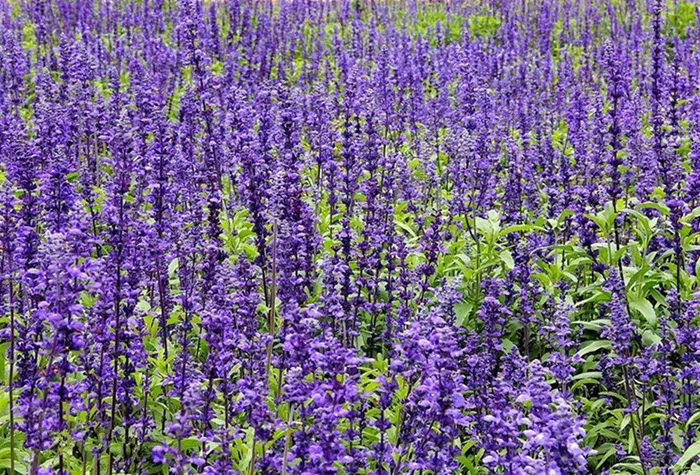Sage flowers, known for their vibrant colors and aromatic properties, are not only a delight to the eyes but also a treasure trove of uses in various fields. From culinary arts to medicinal applications, sage flowers offer a plethora of benefits. This article delves into the multifaceted uses of sage flowers, providing a detailed guide on how to make the most of these beautiful blooms.
Understanding Sage Flowers
Botanical Background
Sage, scientifically known as Salvia officinalis, is a perennial herb that belongs to the mint family, Lamiaceae. It is native to the Mediterranean region but is now cultivated worldwide. Sage plants are characterized by their woody stems, grayish-green leaves, and striking flowers that bloom in shades of purple, blue, pink, or white. The flowers typically appear in late spring to early summer and are known for their tubular shape, which attracts pollinators like bees and butterflies.
Varieties of Sage Flowers
There are several varieties of sage, each with unique flower colors and growth habits. Common types include:
Common Sage (Salvia officinalis): Features purple or blue flowers.
Pineapple Sage (Salvia elegans): Known for its red flowers and pineapple-like fragrance.
Clary Sage (Salvia sclarea): Produces large, showy flowers in shades of pink, purple, or white.
Russian Sage (Perovskia atriplicifolia): Though not a true sage, it has lavender-blue flowers and is often used in ornamental gardening.
Culinary Uses of Sage Flowers
Flavor Profile
Sage flowers have a milder flavor compared to the leaves, with a subtle sweetness and a hint of the herb’s characteristic earthy taste. This makes them a versatile ingredient in the kitchen, suitable for both sweet and savory dishes.
Recipes and Pairings
Salads: Fresh sage flowers can be sprinkled over salads to add a pop of color and a delicate flavor. They pair well with greens like arugula, spinach, and mixed herbs.
Desserts: Sage flowers can be used to garnish desserts such as cakes, tarts, and ice creams. Their mild sweetness complements fruity and creamy flavors.
Beverages: Infuse sage flowers in teas, lemonades, or cocktails for a refreshing and aromatic twist. Pineapple sage flowers, in particular, are excellent for this purpose.
Preservation
To preserve sage flowers for culinary use, they can be dried or frozen. Drying involves hanging the flowers upside down in a cool, dark place until they are completely dry. Frozen sage flowers can be stored in airtight containers or ice cube trays with water for easy use in beverages3.
Medicinal Uses of Sage Flowers
Health Benefits
Sage flowers, like the leaves, are rich in antioxidants, anti-inflammatory compounds, and essential oils. These properties make them beneficial for various health conditions:
Digestive Health: Sage flowers can aid in digestion and relieve symptoms of bloating and indigestion. They can be consumed as a tea or infusion.
Respiratory Health: The anti-inflammatory properties of sage flowers help in soothing sore throats and reducing coughs. Inhalation of sage flower steam can also clear nasal congestion.
Skin Care: Sage flower extracts are used in skincare products for their antimicrobial and anti-aging properties. They help in treating acne, reducing wrinkles, and improving skin elasticity.
Preparation Methods
Tea: Steep fresh or dried sage flowers in hot water for 5-10 minutes. Add honey or lemon for additional flavor and health benefits.
Tinctures: Sage flowers can be soaked in alcohol to create a tincture, which can be used in small doses for medicinal purposes.
Essential Oils: The flowers can be distilled to extract essential oils, which are used in aromatherapy and topical applications.
Ornamental Uses of Sage Flowers
Garden Design
Sage flowers are a popular choice for ornamental gardening due to their vibrant colors and ability to attract pollinators. They can be used in various garden designs:
Border Plants: Sage flowers make excellent border plants, adding height and color to garden edges.
Container Gardening: They thrive in pots and containers, making them suitable for balconies and patios.
Wildflower Gardens: Sage flowers blend well with other wildflowers, creating a natural and vibrant garden setting38.
Companion Planting
Sage flowers are beneficial in companion planting as they repel certain pests and attract beneficial insects. They are often planted alongside vegetables like tomatoes, carrots, and cabbage to enhance growth and protect against pests3.
Cultural and Symbolic Significance
Historical Uses
Sage has a rich history of use in various cultures. In ancient Rome, sage was considered a sacred herb and was used in religious ceremonies. The flowers were often used in garlands and wreaths to symbolize wisdom and immortality38.
Modern Symbolism
Today, sage flowers are often associated with healing, purification, and protection. They are used in modern rituals and ceremonies, such as smudging, to cleanse spaces and promote positive energy3.
Environmental Impact
Pollinator Attraction
Sage flowers are highly attractive to pollinators, including bees, butterflies, and hummingbirds. Planting sage in gardens can help support local pollinator populations, which are crucial for ecosystem health and biodiversity38.
Sustainable Gardening
Sage is a drought-tolerant plant, making it an excellent choice for sustainable gardening practices. It requires minimal water and care, reducing the environmental impact of gardening activities3.
Conclusion
Sage flowers are a versatile and valuable addition to any garden or kitchen. Their culinary, medicinal, and ornamental uses make them a must-have for plant enthusiasts. By understanding and utilizing the various benefits of sage flowers, one can enhance their culinary creations, improve their health, and contribute to a more sustainable and vibrant environment. Whether you are a seasoned botanist or a curious gardener, sage flowers offer endless possibilities for exploration and enjoyment.


